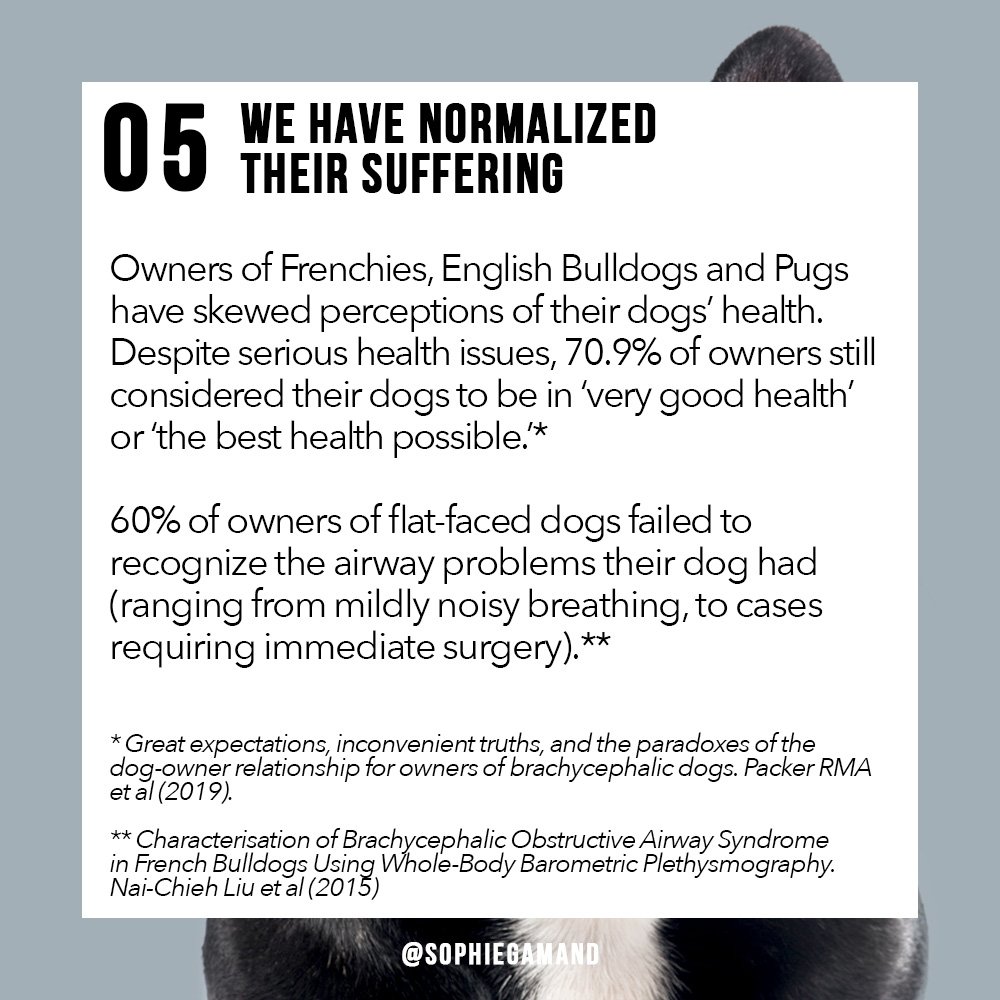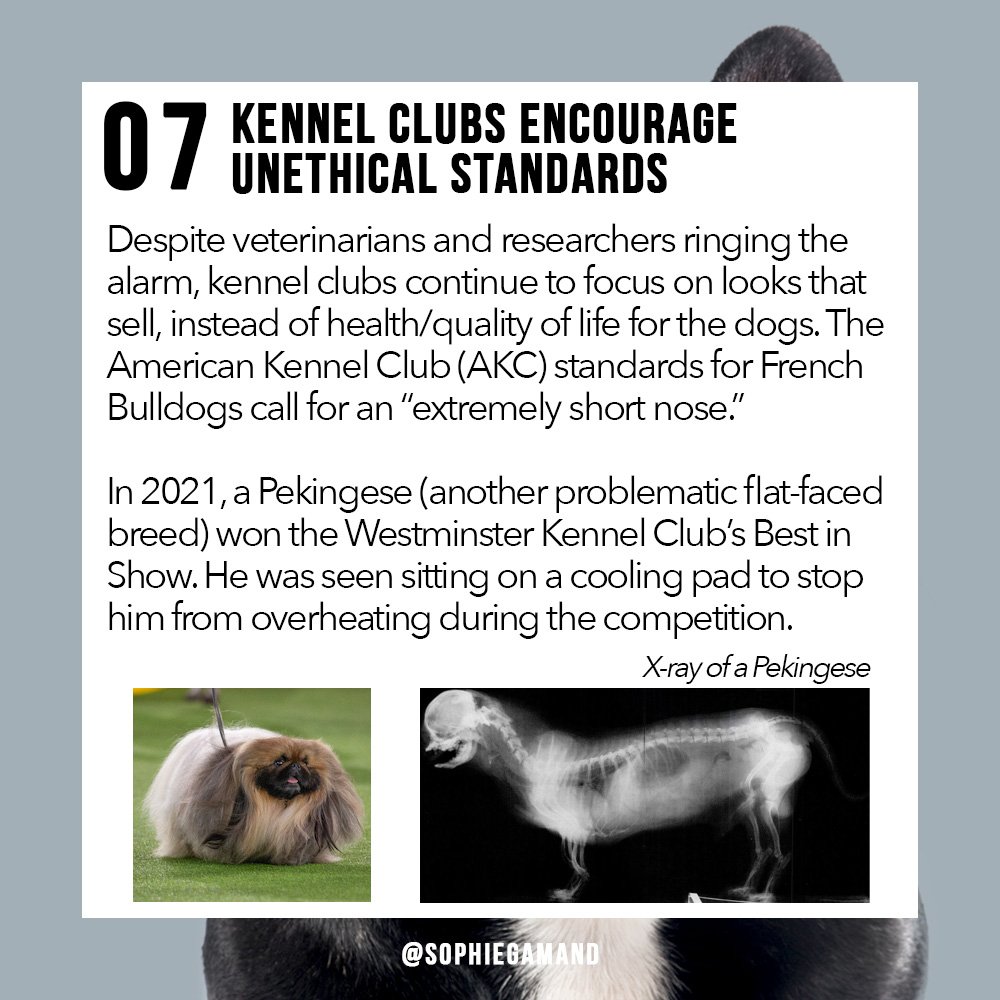7 reasons you shouldn't buy a Frenchie
French Bulldogs and other flat-faced pets (in particular English Bulldogs and Pugs) are controversial, for serious and good reasons. Despite being one of the most popular breeds (with a significant increase in popularity during the pandemic), Frenchies come with a long list of health issues, and major ethical concerns.
A few months ago, I became vocal about these issues on my social media, and was floored by the hundreds of desperate messages I received in return (scroll down for some examples). From Frenchie owners devastated by humongous vet bills and poor quality of life their dog had, to members of the veterinarian community talking about burn out and mental health struggles associated with the constant stream of flat-faced pets they have to treat…
The skull of a pug. (credit unknown)
One thing became clear: the public at large doesn’t know. Or refuses to see. Even owners of these breeds tend to sweep these concerns under the rug. Other owners make the best of what they have, but swear they’ll never own these breeds gain, despite loving them. Vets and researchers have been ringing the alarm for at least a decade, yet breeders and kennel clubs refuse to change. These dogs’ popularity has led to more terrible breeders. The breeders I chatted with were completely oblivious to their disastrous breeding practices. Some argued their dogs were very healthy, yet photos showed deformed bodies, tiny nostrils, mouths wide open, gasping for air. Not to mention the artificial insemination or C-section required to bring these dogs to life.
Together with Pugs and English Bulldogs, French Bulldogs are the breed most used by advertising in the pet industry and beyond. This encourages their popularity, leading to more unethical breeding by people looking to cash in.
We should demand our favorite dog companies review their advertising practices and stop using these breeds to promote their products or services. There are so many amazing, healthy, beautiful dogs of all kinds in the world.
Prime example of the sickening promotion of horrifying breeding by kennel clubs. Click here to read the story behind this magazine spread from 1960.
We have ignored the suffering of these dogs for so long, convincing ourselves that their snorts are cute and endearing. We call them stubborn, when most likely they just cannot breathe properly. It is time we look at ourselves and what we have done. It is time we address our cruel breeding practices and fix them. We cannot look away anymore. Kennel clubs have shown little no interest in fixing their bad breeding practices. There is just too much money (and pride) at stake. It’s going to be up to the public. And perhaps we should start holding breeders financially responsible for the disasters they produce!
Change starts with educating people on why they shouldn’t seek to buy Frenchies, English Bulldogs or Pugs. We must squash the demand for these breeds. To be clear: I want every dog to have a loving home. And some of these dogs do end up in rescue. I hope families will be willing to take them on, but they must be prepared and informed accordingly.
I am hoping that by sharing this information, I can convince people to think twice before buying and supporting the breeding of these dogs.
Thank you for your support.
Sophie
LINKS TO SOURCES CITED IN SLIDES:
SLIDE 1: 81.3% of Frenchie litters are born by c-section, the highest rate after English Bulldogs (86.1%) and Boston Terriers (92.3%).
Source: Proportion of litters of purebred dogs born by caesarean section. Katy M. Evans, Vicki J. Adams (pub. 01 February 2010)
Frenchies are 15.9 times more likely to suffer from difficult births than crossbred female dogs.
Source: Canine dystocia in 50 UK first- opinion emergency-care veterinary practices: prevalence and risk factors. O’Neill, DG., et al. (2017) Veterinary Record 181, 88.
SLIDE 2: A study looked at 2,000 Pugs, French Bulldogs and English Bulldogs, with a youthful average age of 2.17 years. One fifth of the dogs had already undergone at least one corrective surgery, the most common being nostril widening.
Source: Great expectations, inconvenient truths, and the paradoxes of the dog-owner relationship for owners of brachycephalic dogs. Packer RMA; O’Neill DG; Fletcher F; Farnworth MJ (2019).
SLIDE 4: A study found flat-faced dogs “are less healthy than dogs with a more normal canine appearance." Flat-faced dogs have much higher rates of: eye ulcer/trauma (377% higher than in other breeds), skin cancer (86%), fungal skin disease (94%), pneumonia (109%) , heat stroke (146%), heart disease/murmur, digestive issues, dental problems, intervertebral disc disease, and kneecap dislocation.
Source: Brachycephalic Breed Disease Prevalence Study. Nationwide (2017). Click to download the Nationwide study.
72.4% of the young Frenchies studied (median age: 1.3 years) had at least one disorder recorded.
Source: Demography and disorders of the French Bulldog population under primary veterinary care in the UK in 2013. Dan G. O’Neill et al (2018).
SLIDE 5: Despite serious health issues, 70.9% of owners still considered their dogs to be in ‘very good health’ or ‘the best health possible.’
Source: Great expectations, inconvenient truths, and the paradoxes of the dog-owner relationship for owners of brachycephalic dogs. Packer RMA; O’Neill DG; Fletcher F; Farnworth MJ (2019).
60% of owners of flat-faced dogs failed to recognize the airway problems their dog had (ranging from mildly noisy breathing, to cases requiring immediate surgery).
Source: Characterisation of Brachycephalic Obstructive Airway Syndrome in French Bulldogs Using Whole-Body Barometric Plethysmography. Nai-Chieh Liu et al (2015).
SLIDE 7: American Kennel Club breed standards for Frenchies.






































